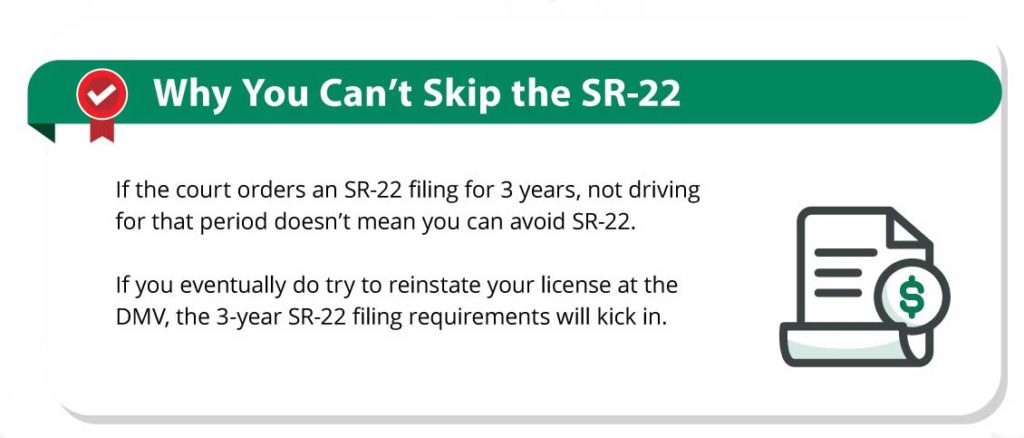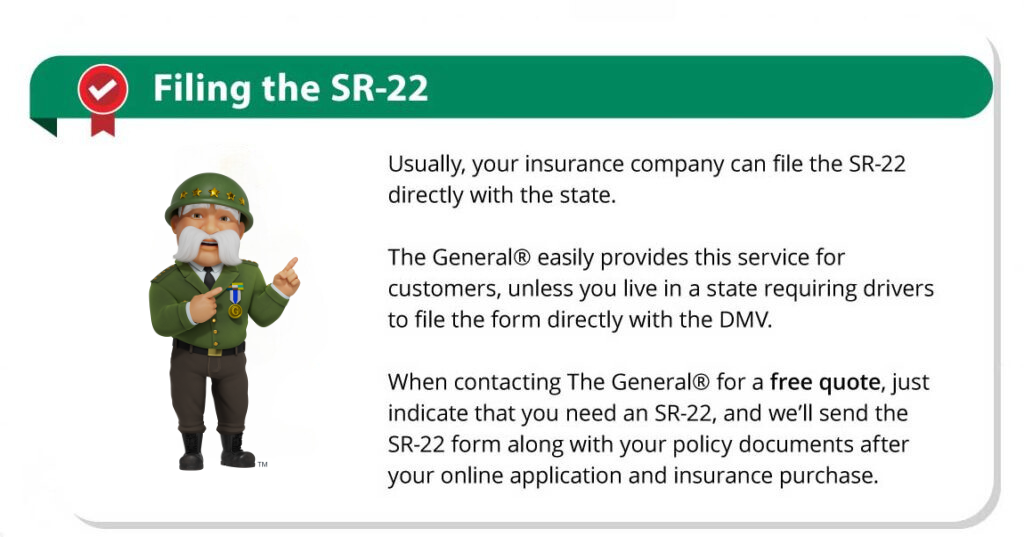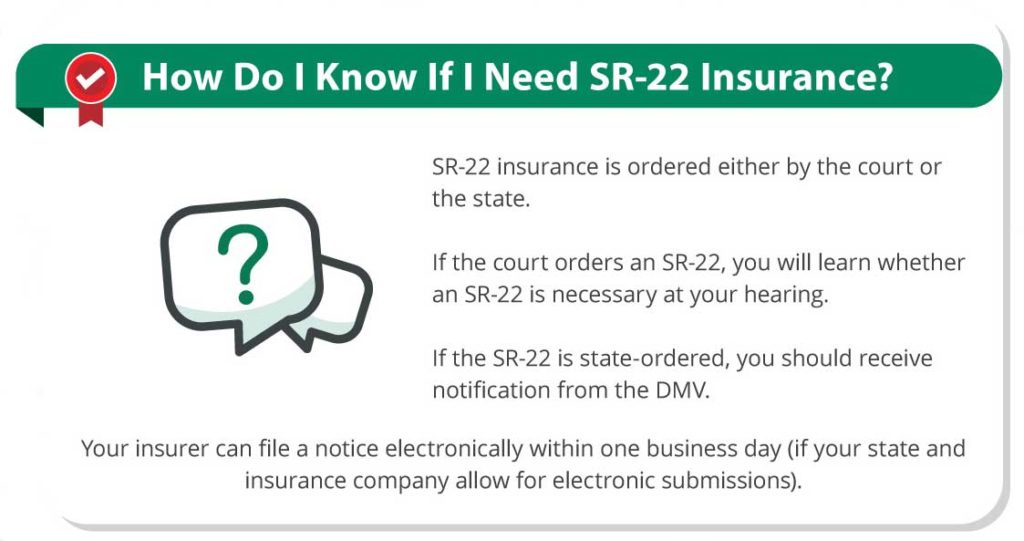What Is SR-22 Insurance and What Does It Do?

Many people requiring SR-22 insurance have never heard of it until they need to file this certificate. If you fall into this category, here’s a basic rundown on what SR-22 insurance is and what it does.
Key Takeaways
What Is SR-22 Insurance?: Contrary to popular belief, an SR-22 is not insurance but a document required by some states. It serves as proof that a driver carries the minimum liability insurance required by law. This certificate is especially important for those who have committed certain traffic violations.
Purpose of SR-22 Filings: The SR-22 insurance certificate, often called the SR-22, is a form that states use to ensure that certain high-risk drivers are continuously insured. It’s a common requirement following serious driving offenses to reinstate or maintain driving privileges.
Navigating SR-22 Requirements: While filing an SR-22 can lead to higher insurance premiums due to the associated driving infractions, it’s needed to meet legal obligations and restore driving rights. The specifics can vary greatly by state, so research your state’s regulations if you need to file one.
Common Misconceptions Around SR-22 Insurance
To start with, we should note that although it’s referred to as SR-22 insurance, an SR-22 isn’t a type of auto insurance. It’s actually a certificate showing proof that a driver has car insurance. Also known as a certificate of financial responsibility, the SR-22 shows the state Department of Motor Vehicles that the driver currently carries the state’s minimum amount of liability insurance.
SR-22 Meaning
Does SR-22 mean anything, or is it simply a form name? SR actually stands for “safety responsibility,” which is an apt way to describe the document. It’s also known as an SR-22 bond or certificate. Another acronym for the SR-22 is “CFR,” which stands for certificate of responsibility.
Only those with particular traffic law violations or criminal offenses must file an SR-22 form (or have their auto insurance company file it for them). If you are required to have an SR-22 and you cancel your auto insurance policy, your insurance company must immediately let the state know you no longer carry insurance coverage with them. The same may hold true if you miss an insurance payment that results in a lapse in coverage. The insurer files an SR-26 form, which cancels out the SR-22 filing. In turn, the state may suspend your license right away.
Note that an SR-26 form is also filed when the SR-22 filing is no longer needed. In this scenario, the SR-26 filing does not result in a license suspension, as you are now a standard driver. Of course, you must continue to carry auto insurance, but the SR-22 filings are typically no longer required unless another serious violation occurs.

State SR-22 Laws
SR-22 regulations are not uniform. They can vary greatly from state to state while some states may not require SR-22 certificates at all. For example, when your SR-22 filing starts is very much a state matter. You may need to file an SR-22 form as soon as you’ve been convicted of a traffic violation. Other states may require that the filing occur soon after an accident or license suspension. Then there are states where the driver doesn’t need to file the SR-22 form until after they get their license back and can drive again.
Contact your state’s Department of Insurance if you have any questions about the SR-22 laws in your state.
Does an SR-22 Actually Provide Coverage?
Since the SR-22 isn’t insurance, it doesn’t cover you if you were involved in an accident or charged with some sort of driving violation.
The SR-22 filing informs the state whether a driver convicted of specific violations is carrying liability insurance. Legally speaking, you can’t drive without having the minimum amount of financial responsibility coverage, which is usually your liability insurance. In other words, if the insurance company contacts the state to let them know you’ve canceled your liability insurance policy, the DMV acts quickly. Since the state doesn’t want uninsured drivers on the road, it usually takes away the violator’s license.
In some states, drivers must also carry uninsured or underinsured motorist coverage. If this is the law in your state, the SR-22 filing will notify the DMV that you are carrying all mandatory coverages. Drivers can still carry collision and comprehensive insurance, but this is not part of the SR-22 filing.
An SR-22 certificate does not affect your ability to file a claim if you are in an accident. If you only carry liability insurance, you are not covered for damage to your vehicle. Even if you have an SR-22 filing requirement, you should still buy the right amount of insurance to protect yourself.
How Do You Know If You Need SR-22 Insurance?
If you’ve been convicted of any of the violations requiring the filing of an SR-22 form, either the court or your insurance company will inform you when an SR-22 filing is needed. SR-22 insurance may be required for any of the following violations and convictions:
Serious collision as the at-fault driver
Driving under the influence
Driving under a suspended or revoked license
Causing an accident while driving uninsured
Reckless driving
Excess points on the license within a short period of time
SR-22 insurance filings aren’t only for those with traffic violations and driving offenses. Failure to pay child support can also result in a court-ordered SR-22 filing requirement.
How Long Do You Need SR-22 Insurance?
Usually, SR-22 insurance is required by law for 3 years. For major offenses, the driver can expect to file an SR-22 for much longer. For example, depending on the state, a drunk driving conviction can mean filing the form for 5 or more years.
Which States Use the SR-22?
Not every state uses SR-22 forms. Some states require the filing of a similar form, the FR-44. Other states have their own systems to keep track of driver violations and car insurance. Currently, the following states do not use the SR-22 form:
Delaware
Kentucky
Minnesota
New Mexico
New York
North Carolina
Oklahoma
Pennsylvania
Unfortunately, you can’t get out of filing an SR-22 form simply by moving to one of these states. These states all have reciprocal agreements with states mandating the SR-22. In short, you must still meet the requirements of the state that is ordering you to file an SR-22 form.
What If I No Longer Own a Vehicle?
Maybe the accident causing the need for an SR-22 filing also totaled your car and you haven’t replaced it. Perhaps you just don’t own a vehicle, but you do have access to someone else’s car and drive it regularly. Should that person be a member of your household, different rules apply, but if they are a friend lending you a car, you will still need coverage and an SR-22 filing. In this situation, you should buy a non-owner insurance policy, which typically only covers liability.
If you borrow a car from a member of your household, such as a parent, insurance companies will usually require your name on their policy.

SR-22 and Car Insurance Premiums
The insurance company usually won’t charge a lot for filing the SR-22 form or may not charge at all. However, expect your car insurance premiums to rise considerably once an SR-22 filing is necessary. That increase is not due to the SR-22 per se, but because of the underlying reason for the filing.
How much will your premiums go up? Again, that depends on your state and the offense. The simple answer is “quite a bit.” At a minimum, expect your premiums to rise by about 50 percent. You could find your premiums almost doubling. However, all violations should eventually expire, and your premiums will then decrease.
Try to save money on premiums in other ways, such as buying a used car that doesn’t require collision insurance. Keep in mind that you can usually only do this if you purchase the car outright, rather than take out a loan. Lenders will typically mandate that you maintain collision and comprehensive insurance on a car to protect their interests.
How to Reduce SR-22 Insurance Costs
Navigating the complexities of SR-22 insurance can be challenging, especially when considering the potential rise in insurance premiums. However, there are several strategies you can take to help manage and even reduce the cost of your insurance after an SR-22 filing. Here are some tips to consider:
Shop Around for Better Rates: Don’t settle for the first quote you receive. Since SR-22 insurance requirements can vary by provider, it’s important to compare quotes from multiple insurers. This will help ensure you find the best possible rate for your SR-22 coverage.
Maintain a Clean Driving Record: Keeping your driving record clean is one of the best ways to reduce your premiums over time. Avoiding accidents and traffic violations can demonstrate to insurers that you are a lower risk, potentially lowering your rates.
Complete a Defensive Driving Course: Many insurance companies offer discounts to drivers who successfully complete an approved defensive driving course. This not only enhances your driving skills but also shows your commitment to safe driving, which can lead to lower premiums.
Ask About Available Discounts: Always ask your insurer if you’re eligible for any car insurance discounts. Most companies offer discounts for bundling your auto insurance with other policies, maintaining a good driving record, being a good student, or even for continuous insurance coverage.
Regular Policy Reviews: Make it a practice to review your insurance policy annually. This ensures that your coverage still aligns with your needs and allows you to keep an eye on potentially better rates from other insurers or renegotiations with your current provider.
By applying these strategies, you can better manage the financial impact of carrying SR-22 insurance. Remember, understanding what SR-22 insurance is and how it affects your coverage options can help you make informed decisions and find cost-effective solutions.

Ride With The General®
At The General®, we know that many insurers do not cover drivers requiring an SR-22. Since we have specialized in covering high-risk drivers for over 60 years, there’s no need to worry if you need such a filing. If you weren’t previously in the high-risk pool, the necessity of filing an SR-22 form will put you there for the length of the time the filing is mandated.
You can count on The General® to take care of your SR-22 auto insurance filing requirements. In some states, we can even file the SR-22 form with the state electronically, often on the day you buy your policy from us.
The General® includes the SR-22 insurance form when you purchase our car insurance online. Just let us know you need an SR-22 form when buying your policy. We can also explain all the details of the SR-22 filing so that you understand what is needed and what we do.










